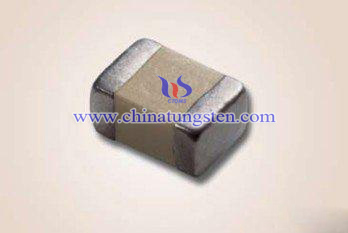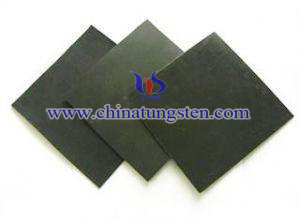Tungsten Powder and Capacitor Dielectric
- Details
- Category: Tungsten Information
- Published on Friday, 08 July 2016 16:30
A method for producing a capacitor includes: a dielectric body (10) composed of basic alumina powder (12) mixed with tungsten powder (14), interposed between a pair of electrodes (16,18) disposed opposite to each other. The method includes the steps of: after a conductive alumina ceramic body has been formed by mixing the tungsten powder (14) with the alumina powder (12), providing the pair of electrodes (16,18) while interposing the conductive alumina ceramic body therebetween, and then intermittently applying an electric current or voltage to the electrodes (16,18), high enough to break conductive paths formed in the conductive body by the tungsten powder (14), so that the conductive body is converted to the dielectric body (10).
The present invention relates to a capacitor, a method for producing the same and method for producing a dielectric body. Particularly, this invention relates to a capacitor wherein a dielectric body formed of a basic dielectric substance mixed with conductive substance is interposed between a pair of electrodes, a method for producing the same and a method for producing a dielectric body obtained by mixing conductive substance in a basic dielectric substance.
A capacitance of a capacitor is given by the following formula: C = (ε0) (ε1) (S/d) wherein
C: capacitance of capacitor
ε0: relative dielectric constant in vacuum
ε1: relative dielectric constant of dielectric body
S: area of dielectric body
d: thickness of dielectric body
To increase the capacitance (C) of the capacitor, it is necessary to enlarge the area (S) of the dielectric body or reducing the thickness (d) of the dielectric body.
In Japanese Unexamined Patent Publication (Kokai) No. 3-87091, a method for producing an alumina ceramic circuit board is proposed wherein a green sheet formed of aluminum powder as a ceramic material added with molybdenum powder and/or tungsten powder in a range between 5 and 50% by weight is fired at a predetermined temperature.
According to the method disclosed in this Patent Publication, it is possible to easily form a capacitor within the alumina ceramic circuit board.
In this production method, if an amount of molybdenum powder and/or tungsten powder gradually increases, the relative dielectric constant of the resultant ceramic dielectric body also increases.
However, if the added amount of conductive substance exceeds 50% by weight, a resistance of the obtained ceramic body suddenly decreases to exhibit electrical conductivity.
Accordingly, in the method disclosed in the Patent Publication, it is possible to increase the mixed amount of conductive substance to about 50% by weight, whereby the relative dielectric constant of the resultant dielectric body is at most 17 or so.
On the other hand, there has been a great demand for a dielectric body having a higher dielectric constant in a circuit board of alumina ceramic or the like. If a dielectric body having a higher dielectric constant could be formed, effective means would be obtained for forming a capacitor having a high capacitance in the circuit board.
Inventors of the present invention studied to achieve the above object. As a result, a conductive ceramic body was molded by firing at a predetermined temperature a green sheet formed of alumina powder mixed with tungsten powder of 60% by weight. Then, a pair of electrodes were provided opposite to each other while interposing the molded ceramic body. It was found that the ceramic body is converted to a dielectric body by applying a high current or voltage in a pulsed manner to the electrodes. Thus, the present invention was completed.
US-A-5144529 discloses a capacitor formed by dispersing needle-like metal particles coated with an oxide layer in a synthetic resin film. The particles are oriented parallel to electrodes on the resin film by a magnetic field, prior to curing of the resin film.
Accordingly, in a first aspect, the invention consists in a capacitor including a dielectric body interposed between a pair of electrodes disposed opposite to each other, said dielectric body being formed by firing or curing a conductive body formed from a mixture of a basic dielectric substance and a conductive substance,
characterized in that conductive paths provided by the conductive substance in the conductive body are electrically broken by intermittently applying an electric current or voltage to the electrodes.
In a further aspect, the invention consists in a method for producing a capacitor including a dielectric body composed of a basic dielectric substance mixed with conductive substance, interposed between a pair of electrodes disposed opposite to each other, said method comprising the steps of: Forming a conductive body by mixing the conductive substance with the dielectric substance,providing the pair of electrodes on opposite sides of the conductive body, firing or curing the conductive body, and intermittently applying an electric current or voltage to the electrodes whereby conductive paths formed in the conductive body by the conductive substance are electrically broken, so that the conductive body is converted to the dielectric body.
In a further aspect, the invention consists in a method for producing a dielectric body wherein a conductive substance is mixed with a basic dielectric substance comprising the steps of: forming a conductive body by mixing the conductive substance with the dielectric substance, interposing the conductive body between a pair of electrodes, firing or curing the conductive body, and intermittently applying an electric current or voltage to the electrodes to electrically break conductive paths formed in the conductive body by the conductive substance, so that the conductive body is converted to the dielectric body.
According to the present invention having such structures, it is possible to obtain a ceramic or plastic body exhibiting the conductivity by mixing a conductive substance exceeding 50% by weight or 15.9% by volume in a ceramic material exhibiting the dielectric property.
It is also possible to form a conductive body capable of being converted to a dielectric body in a circuit board of alumina ceramic at the same time as the circuit board of alumina ceramic is fired, by using, as ceramic material, alumina powder and, as conductive substance, tungsten powder, tungsten oxide powder, molybdenum powder or molybdenum oxide powder.
According to the present invention, the conductive body is formed by mixing a large amount of conductive substance in the dielectric substance. Conductive paths are formed within this conductive body.
Then, the conductive body is converted to the dielectric body by intermittently applying a high current or a high voltage to the electrodes while interposing the conductive substance between them to electrically break the conductive paths.
The conductive body converted to the dielectric body as mentioned above has a higher relative dielectric constant compared with that of a dielectric body formed by mixing therewith conductive substance of an amount capable of substantially maintaining the insulating property of the dielectric body.
It is surmised that the reason therefor is that an extremely thin dielectric layer, compared with a dielectric layer in a dielectric body wherein a smaller amount of conductive substance is mixed with the dielectric substance, is formed on the surface of a particle of the conductive substance forming a conductive path.
Thus, according to the present invention, it is possible to obtain the dielectric body having a higher relative dielectric constant even though dielectric substance having a lower relative dielectric constant is used.
A dielectric body forming a capacitor according to the present invention can be obtained by mixing conductive substance in dielectric substance.
Ceramic materials or organic insulating materials such as plastic or others may be used as the dielectric substance. Particularly, alumina powder, aluminum nitride powder or glass powder can be suitably used as the ceramic material.
The conductive substance suitably mixed with such dielectric substances is preferably selected while taking the relationship with the dielectric substance into account. For example, when a dielectric substance capable of forming a ceramic body through a high temperature firing is used, a ceramic material such as alumina powder, or a powder of metal having a melting point in the vicinity of that of the ceramic material is favorably used, such as tungsten powder, tungsten oxide powder, molybdenum powder or molybdenum oxide powder.
On the other hand, when an organic insulating body such as plastic or glass powder is used as the dielectric substance, powder of Au, Cu or Ag is preferably used, which has a lower melting point than that of tungsten powder or the like but is excellent in the electrical conductivity.


| Tungsten Powder Supplier: Chinatungsten Online tungsten-powder.com | Tel.: 86 592 5129696; Fax: 86 592 5129797;Email:sales@chinatungsten.com |
| Tungsten News & Prices, 3G Version: http://3g.chinatungsten.com | Molybdenum News & Molybdenum Price: http://news.molybdenum.com.cn |



 sales@chinatungsten.com
sales@chinatungsten.com